
What Is IIoT/Industry 4.0 (Business) Integration?
Industry 4.0 involves IIoT-driven intelligent systems, and SEEBURGER facilitates data and process integration to aid companies in their Industry 4.0 journey.
Through digitalization, networked intelligent and autonomous systems are entering industry and changing it towards Industry 4.0. The basis is the Industrial Internet of Things (IIoT). This enables the networking of real and virtual machines and processes in industry within and between companies.
Why are data and process integration also important for IIoT and industry 4.0? How can SEEBURGER support you in your company’s journey to an industry 4.0 firm? Read on for a comprehensive introduction to business integration for industry 4.0 and IIoT and find out how you can guide your own digital transformation, with you in the driving seat.
IIoT / Industry 4.0, Disruption or Evolution?
The autonomy and intelligence of objects and devices has been steadily increasing. Coupled with having access to data wherever you are via the internet, it has become far easier for business partners to cooperate with each other. This has had an enormous effect on productivity and fundamentally changed the entire economy. Indeed, these developments could be considered as radical as the changes which issued in the previous three industrial ages.
What are IIoT and Industry 4.0? Computer technology has been present in all areas of industry for decades. It significantly supports us in our planning, decision and implementation processes. At the same time, the internet has become the most important communication channel and marketplace for products and services. However, it has only been through these developments encroaching into our tangible space, even down to our household and leisure objects, that the potential of industry 4.0 has been recognized. A key element is the digital twin, which some time ago was used exclusively in the area of simulation for virtual safeguarding, but is increasingly being used in other areas of production, logistics and after-sales, as a data node for providing data to its real instance. Increasingly, it is becoming an important business entity that is directly integrated into value creation as well as business processes. By networking with other digital twins via platforms, new exchange processes are emerging in B2B, with new forms of interaction and transaction. Recently, new business models have been realized on the basis of digital twins, such as product-as-a-service, which focus on the capabilities and benefits of things (plants, machines, devices) and provide them based on performance and use.
This enables a company to tailor their production even closer to customer requirements, fulfilling individual wishes right down to a single, fully-customized product, within a feasible budget and time frame. The logistics sector is moving towards service-orientated on-demand logistics, while services, after sales, marketing and distribution are beginning to create their own data-based commercial ecosystems which give root to new service models. For this, IIoT serves both as a network and a medium. It enables more comprehensive networking in industry 4.0 and therefore new ways of optimizing processes even beyond the company’s four walls. However, it also enables completely new ecosystems and new ways of doing business, newly addressing aspects of monetization, scalability, but also decentralization, participation and cleverer ways of dealing with data.
All of this assumes that the technical systems, applications, services and equipment in a company can seamlessly interact with each other. This often starts with a targeted harmonization of data and process integration, which continues to be a challenge for many companies, because in the area of digitalization many still need a boot camp in preparing Industry 4.0.
Where are companies today in regard to industry 4.0?
On the road to Industry 4.0, companies have already upgraded their information systems, or are in the process of doing so, to be ready for the changes in business processes. Cloud-based systems, but also the increasing availability of SaaS systems, are still being used to quickly address the lack of capabilities for data collection or processing in their data hub environments. However, technical factors such as insufficient data security as well as organizational factors such as the future role of IT and uncertainties in the development of new enterprise architectures are still seen as the biggest hurdles in the implementation of IIoT/Industry 4.0 projects.
When asked which technology was considered a "game changer" for their organization, IIoT ranked fourth just a few years ago, after AI, data analytics and cloud topics. At that time, the potential and possible applications were still being explored. In the meantime, all four technologies have become permanent fixtures on companies' modernization agendas. It is much more about the question of how companies can be sovereignly integrated and proactive in digital ecosystems of the Internet of Things. In this context, there is an increasing decentralization and democratization in the organizations. This includes the cloud and platforms, data analytics and AI, but also the integration of things into business processes in the sense of IIoT, which form individual data hub environments for digital value creation.
Analysts are also observing greater autonomy in business units that are dissatisfied with the quality and delivery times of central IT organizations. Based on cost-effective services and solutions, from as-a-service provisioning to cloud infrastructure and low-code/no-code environments, they are driving their own initiatives. At the same time, they warn of the dangers of this inherently positive trend, such as the fragmentation and increasing inefficiency of organizations. To be successful, a new platform architecture must be established to define the technical platform and core services that will be used by teams in individual business units. One of these core services is the specialization of B2B and business integration across all enterprise communication channels.
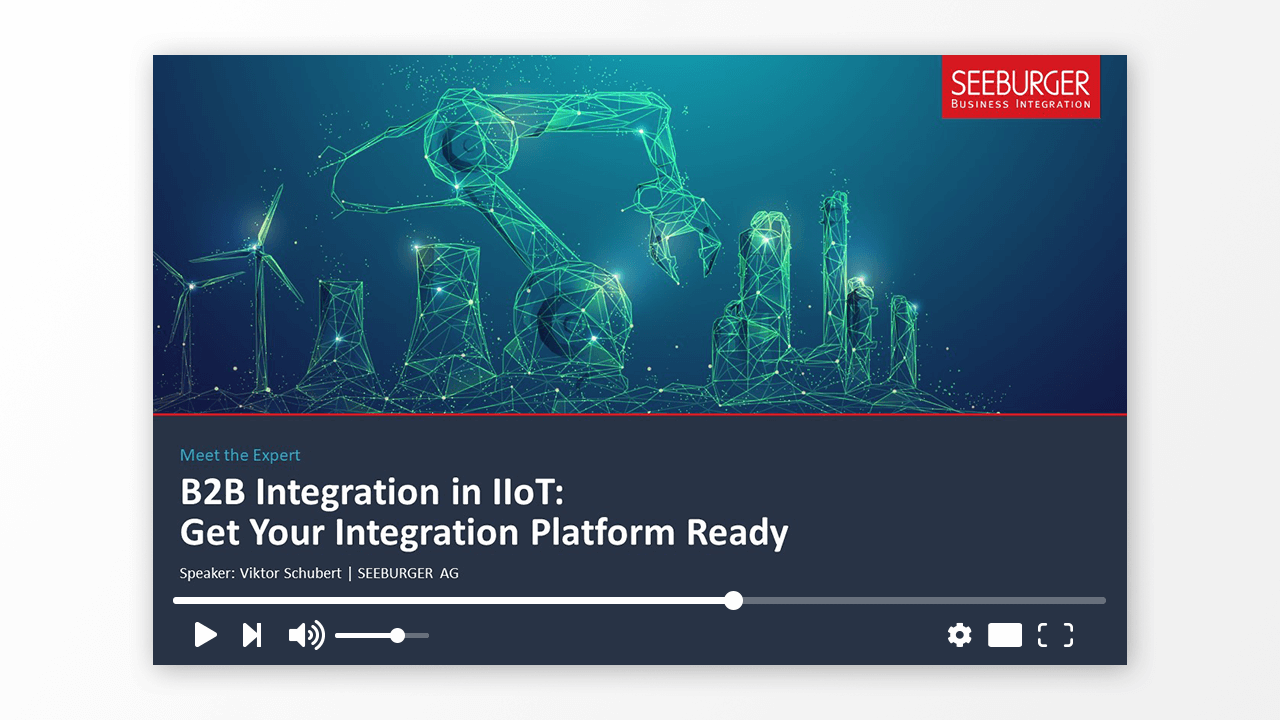
Examples of IIoT and Industry 4.0 in Practice
Real world examples of IIoT and industry 4.0 in use can be found in a variety of areas. A major area of application for industry 4.0 is in the automation and optimisation of operations through intelligent, autonomous, technical systems. New forms of man and machine working together are being developed in industry (cyber-physical systems). This means that individual customer requests for highly customised products all the way down to a batch size of just one, to be manufactured.
A further driving force for the increased use of IIoT and industry 4.0 solutions is meeting individual customer expectations. Consumers no longer only expect a high-quality product. They want to also be able to take up associated services to optimisehow effectiveness and efficiency of the product’s functions. In order to meet this demand, companies are now needing to set up entire digital ecosystems. These are used in all areas of business, from Research and Development through to Marketing and Sales via production, logistics and after-sales services. Indeed, if you consider smart cities or the analysis and use of weather data, you can see that digital ecosystems reach far beyond the commercial world.
In collaborative product development data on user behaviour and product condition plays a significant role in developing new and improved products. So that production processes can run smoothly with no unplanned downtime, maintenance providers can pull data on running time and condition directly from the machine itself to plan regular servicing and recognise impending faults before they cause the machine to break down - either temporarily or for good. This is known as predictive maintenance. Modern track and trace techniques open up wonderful opportunities in logistics to use sensors to determine in real time where goods currently are, meaning that delivery times can be precisely calculated for both production planning and sales. Smart products open up brand new avenues in after sales. Washing machines, for example, could send data on the number of cycles spun and other usage statistics directly to the manufacturer, setting the stage for both maintenance and service offerings on the one hand, and pay-per-use models on the other hand. Marketing and sales have access to sales figures in real time, sent directly from the point of sale (POS), which gives them a consistently up-to-date basis for planning campaigns and promotions, as well as for measuring customer satisfaction.
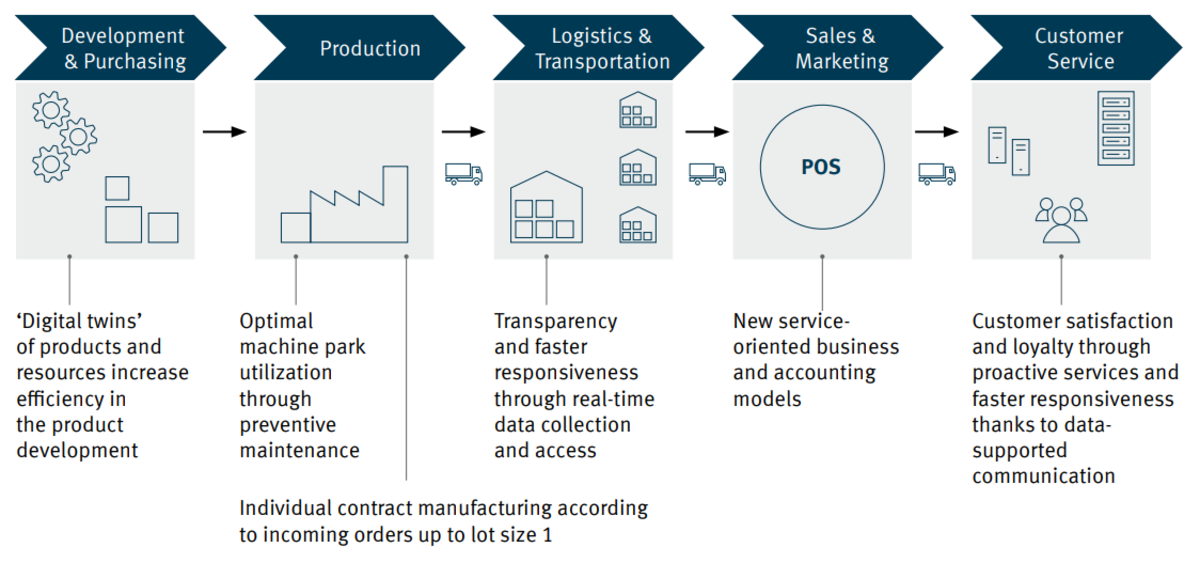
The possibilities opened up through IIoT and industry 4.0 solutions are manifold. However, a significant challenge set by both IIoT and industry 4.0 is to get your IT infrastructure in a good enough shape to take advantage of them.
What is IIoT integration and what can it do?
What is IIoT integration and what can it do?
The industrial, manufacturing economy depends on reliable and efficient production resources and value chain processes. Should new services and intelligent (autonomous) systems be introduced into the production process, it’s important to keep these manageable and sensible for both employees and the organisation as a whole.
The increasing networking of the real and the virtual world in every part of a company requires the ability to integrate with hybrid system landscapes. This is not just about providing or using classic (program) interfaces of large cloud and software systems at the level of standardized enterprise processes. It is about providing the capability of end-to-end/hybrid networking at new levels of interaction of individual things and their digital twins. This capability includes all necessary forms of end-to-end data exchange and data integration into value networks. This also includes new forms of publishing or using microservices and making them available in dathub environments (internal and inter-company data lakes/data pipelines as well as external dataspaces/marketplaces).
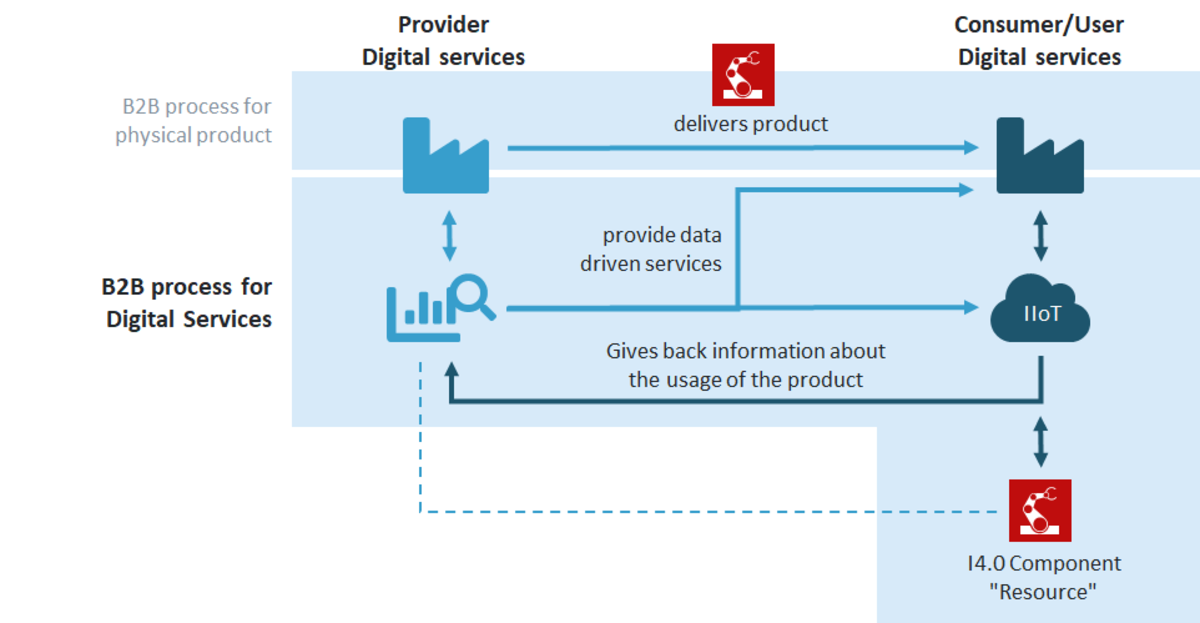
Companies continue to face the task of increasing the share of use and provision of digital services (such as AI) in their value creation and business processes. However, this poses new challenges in terms of data governance. Particularly in the case of forms of data exchange based on digital twins and further resources such as IaaS/PaaS/SaaS, customer and supplier relationships and collaboration in B2B are thus also being redefined. The digital transformation requires companies to pay attention to the following perspectives in the alignment of their integration strategy, which are important for future business success.
Perspectives of IIoT Integration
IIoT and Industry 4.0 integration, which is initially designed internally, must invariably also take the perspective of the entire value network and B2B processes. Here, the focus is on effective, efficient and secure cross-company collaboration. The optimization of logistics processes, from end-to-end supply chain monitoring to production processes and digital ecosystems, is increasingly based on networking as well. Often this starts with the exchange of engineering and product data or an existing EDI partnership, which necessitates further integration of cloud services (platforms) or things and applications to control and automate processes across the board. In the future, digital twins as business entities will be the focus of further exchange processes that take into account services/apps in addition to data (batch or stream).
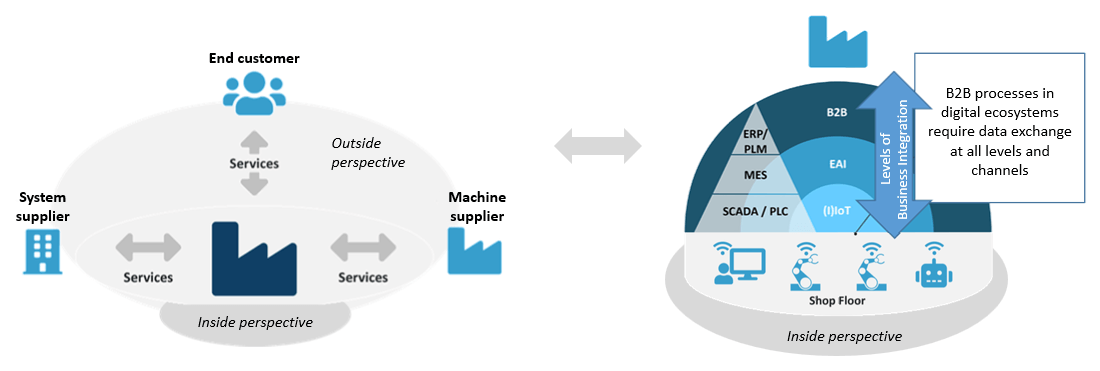
Use Cases
Before the physical machines are delivered, a digital machine folder is created and filled with the supplier’s files. These are used for virtual commissioning and are then kept in the planning systems as a digital model of the machine during the start-up and usage phases and in the future as a digital twin. The SEEBURGER BIS Platform assumes the integration function as a hub between IIoT platforms and production IT in order to automatically record adjustments and states of processes and resources, for example. With the help of the model basis stored in the BIS, process and machine data can be integrated in a normalized form for further processing steps. This forms a basis for commissioning and adaptation measures as well as the systematic and efficient handling of change capability. The efficiency thus achieved in the change and adaptation processes of production forms an essential basis for the expanded use of intelligent and autonomous systems.
The SEEBURGER BIS ensures an event-driven, context-sensitive information flow between the process controller, machine operators and monitoring systems, these days often accessible to employees on a mobile device. This is all necessary to ensure that enough raw materials and components are available at any time, to secure flexibility and to enable order-driven production. If a specific order requires adjustments to be made to the process or further functions to be added to the production facilities, the BIS lets you either make these directly or communicate them to the operators. The BIS operates as middleware and an integration service bus to ensure inter-operability and information flow between the systems on the shop floor.
Manufacturers using Vendor Managed Inventory (VMI) needs to use a predicative needs analysis. Using BIS, Kanban-based production facilities can be extended to continually – or periodically – exchange information on components used and required. This is then compared with service and supply capacity so that any necessary delivery can be organized quickly.
Not only the large number of configuration and setup options offered in the case of modification measures, but also digital services in operation and maintenance, for example for processing GIS and sensor data, increase the productivity and efficiency of machine use enormously. By integrating additional IIoT-based services as well as data analysis, customer-specific assistance systems can be realized, which are made available directly in the work process via corresponding apps. BIS enables the necessary infrastructure and integration solutions for such service platforms, which also allow medium-sized machine suppliers to advance their development into product service providers. Examples of implementation here range from suppliers of large wood-based material plants, to machine tool suppliers, to suppliers of agricultural technology.
Challenges in IIoT integration
Architectural levels in IIoT integration
In Industry 4.0, products and resources carry a digital image of themselves (digital twins). This real and this digital world need to be brought together – integrated. This involves connecting data flow through standardized interfaces, as well as creating an administration level which can uniquely identify both the real objects and their digital twins and communicate with them both.
IT architectures are changing. In order for companies to participate in and shape a networked digital ecosystem, it is necessary for them to upgrade their integration capabilities at all levels in order to be able to offer new, data-driven services. These are, on the one hand, the individual real "things," assets and their peripherals (edge layer), the corresponding company-owned and external platforms (platform layer) that grant access into the digital ecosystems, and into the company's own IT landscape with its necessary backend/management systems and applications (EAI layer). All three layers are increasingly dominated by cloud-based technologies and form their own specific data hub environments that enable business units to increase the productivity of their processes and resources via their own data processing (e.g., using AI, RPA).

In terms of IIoT integration, appropriate capabilities for describing and processing the data (streams) must be maintained across the enterprise for coordinated data and process integration that allows coupling between the things themselves, business and engineering backend systems, and operational process control. The following requirements must be taken into account:
Demands on integration
Flexibility:
Communication technologies in the IIoT focus on targeted application areas, but are often in competition with each other. Many of them establish themselves as the standard for a certain period of time. For TCP-based networks, for example, MQTT and also AMQP are very common, often for smart home and smart city, supplemented by protocols such as ZIGbee or radio technologies such as LoRaWAN. An important communication and data integration technology in the field of Industrial Internet of Things is OPC UA, which defines further areas of information modeling and information description. IIoT integration is often associated only with the connection of devices in the sense of communication technology. However, this does not cover the whole picture. Only through the availability of these signals and data in the sense of the vertical integration dimension to a digital twin, with its own, web-based APIs, is it possible to speak of IIoT integration. From protocols to formats, integration must be capable of providing this data and be able to deal flexibly with the connection of different communication technologies and data models.
Security:
Naturally, IT, file and device security need to be sustainably secured from the very beginning for the entire security lifecycle. In a complex digital ecosystem, there are always vulnerable components that can become a gateway for attacks, with new vulnerabilities being discovered every day. Taking a security-by-design approach requires companies to consider security issues in all areas and at all levels from product development. And integration moves need to ensure that data security and by extension data sovereignty is not compromised.
End-to-end:
By using reference models and recognized standards in interfaces – such as APIs – you can ensure that your systems and your partners’ systems can work with each other. This interoperability requires data to follow a common semantic model so that master data can be merged with data from processes and machines. It’s only then that companies can take proper advantage of this data to support decision-making, to support workflows through new digital services and to increase quality and productivity in processes. Integration needs to be carried out in a structured, logical way to ensure the aspired information flow between different areas.
Consistency:
Newer technologies for processing and analysing data from distributed systems (big data, analytics and AI) are essential components of a system in this era of industry 4.0. They enable an ever growing mass of data from networked systems, applications and objects to be merged and analysed. Companies use the insights from this analysed data to kick start new automation and optimisation measures. This often begins by monitoring, gathering and analysing data from inventory systems and sensors in the manufacturing facilities, and leads to context-based evaluation of aggregated data, maybe progressing to company-wide integration approaches (such as using a manufacturing service bus (MSB)). The aim is to increase the degree of automation of processes and individual resources by enabling them to autonomously make decisions and alterations through intelligent systems. To this end, they also need to be supplied with a flow of relevant data. Consistency is key: decisions and processes are linked, and your integration approach needs to always bear this in mind.
In order to leverage the potential of Industrie 4.0, IIoT (business) integration must ensure the provision, use and control of new data-driven services both within and across enterprises for digital twins, data hubs (cloud environments for analytics/automation and data mesh applications) and business applications. Cross-industry approaches lead to the coexistence of multiple technologies and data standards, making it almost impossible to build B2B business processes in the Industrie 4.0/IIoT environment without integration solutions. Whether the digitization approach focuses on performance (PLM), customer (CRM), or value creation (SCM), the central requirement remains a cross-discipline and cross-company data and information logistics system that can handle the increase in data, interfaces, and services flexibly, consistently, and securely. The increasing design of data spaces for the exchange of data but also services via digital twins increases the requirements for uniform, company-wide governance via distributed decentralized B2B integration nodes.
Hybrid integration platforms create the basis for the required interoperability between data domains for processes, resources and products in order to implement business processes for digital services on this basis.
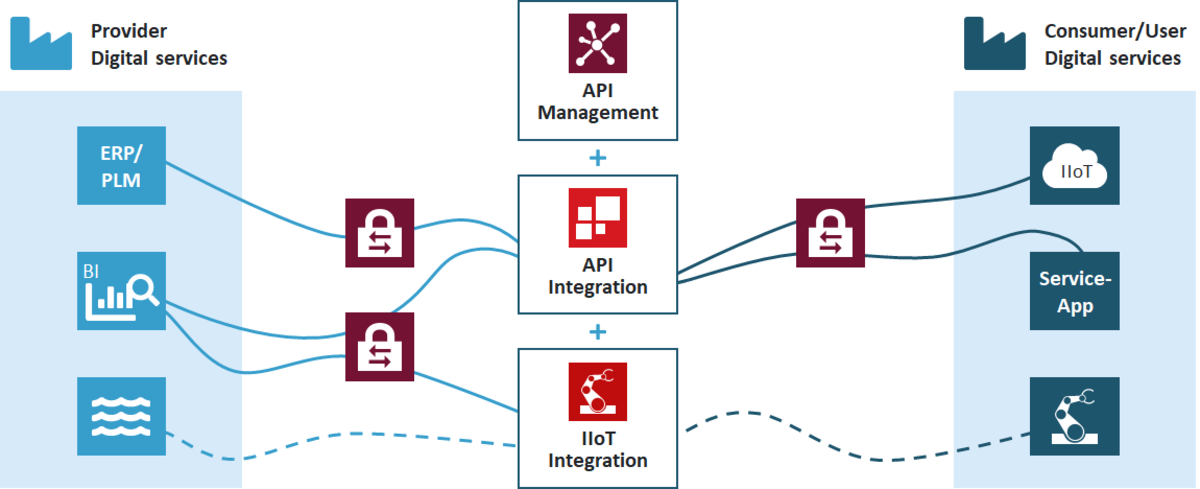
Function overview of the IIoT capability of the SEEBURGER BIS platform
The SEEBURGER BIS IIoT capability supports companies in solving the integration tasks associated with Industrie 4.0 projects. Integration and analysis capabilities are extended by the level of networked products and machines in the real world and transfer old proprietary interfaces into standard formats to lay a sustainable foundation for a wide variety of integration projects.
The BIS IIoT Gateway collects and stores data from IIoT edge devices, control systems or IIoT platforms. Via API profiles, they are made available to (technical) applications and back-end systems at the planning and management level and linked to data analytics environments.
BIS IIoT Management bundles a variety of web-based applications for managing APIs and services to IIoT devices on the shop floor or in the field. It provides customized role-based functions for asset and process data management, configuration, monitoring and analysis.
IIoT Integration Dimensions
Asset/IIoT Integration
No matter whether customer-specific value-added services are to be created and integrated or IIoT deployment requires the empowerment and optimization of business processes - the SEEBURGER BIS IIoT capability extends the integration capability, flexibility and automation of business IT down to the atomic level of product instances. The SEEBURGER BIS IIoT capability bridges the gap between the "things" of the real world - products, machines, plants - and the digital world, i.e. intra- and inter-company business processes and enterprise applications. In this way, individual customer requirements can be addressed more quickly and in a more targeted manner without overburdening the business IT landscape.
Benefit:
Horizontal and vertikal IIoT Integration
An essential aspect of Industry 4.0 is the use of intelligent facilities and machines and the resulting adaptability of production systems. With the IIoT capability of the SEEBURGER BIS Platform, control-related communication (ERP, MES, PLC) is supplemented by other required information flows between store floor and pot floor - interoperably, securely and flexibly. The BIS IIoT capability relies on open industry standards (e.g. OPC UA) to provide integrated information logistics - vertically, from the individual IIoT device, through IT systems and applications, to networking with external partners, and horizontally across the entire value creation lifecycle.
Benefit:
IIoT service orchestration and analytics
The flexible adaptation of information logistics for monitoring and analyzing IIoT services is supported by the BIS IIoT capability with tools for process design, monitoring and evaluations. These include modern data hub environments (Hadoop/Kafka) and their use in IIoT.









